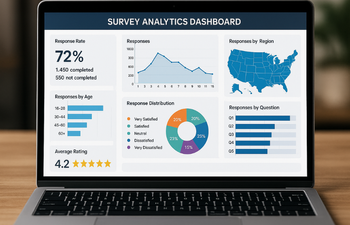Using Online Surveys in Higher Education: Feedback & Evaluation
Explore how to use online surveys in higher education for student feedback, course evaluation, and institutional improvement.

Introduction
Online surveys in higher education have revolutionized the way institutions collect, analyze, and act on feedback. From enhancing curriculum development to improving administrative services, online surveys offer a flexible, scalable, and data-driven approach to continuous improvement. Their ease of distribution, accessibility, and anonymity make them a go-to tool for universities aiming to better understand their students and faculty. In this guide, we’ll explore how to use online surveys effectively across different dimensions of higher education.
The Importance of Feedback in Higher Education
Effective learning environments are built on feedback loops. Student insights can reveal what works and what doesn’t in a course, helping educators make necessary adjustments. Similarly, institutional feedback helps improve campus facilities, services, and student satisfaction.
Benefits of Using Online Surveys in Academia
Online surveys present several advantages over traditional paper-based evaluations:
- Real-time data collection and analytics
- Higher response rates through convenience and accessibility
- Cost-effective distribution with minimal logistics
- Easy customization and branching logic
- Compatibility with remote and hybrid learning environments
For tips on crafting effective survey questions, see our post on How to Write Survey Questions People Actually Want to Answer.
Types of Surveys Used in Higher Education
There are multiple forms of surveys institutions can deploy depending on the goals:
Student Feedback Surveys
Student feedback surveys aim to understand how learners perceive the curriculum, instructors, and learning environment. They are essential for refining pedagogical approaches and ensuring student-centric learning.
Designing Effective Course Evaluation Surveys
For best results, surveys should be specific, concise, and relevant. Key areas to evaluate include:
- Instructor knowledge and communication
- Course structure and organization
- Relevance of materials
- Assessment fairness
- Engagement and interactivity
Best Practices for Online Survey Distribution
Timing, platform, and presentation impact response rates. Here’s how to maximize effectiveness:
- Use platforms like Google Forms or Qualtrics with mobile-friendly designs.
- Send surveys during low-stress periods, avoiding exam weeks.
- Offer incentives such as participation certificates or giveaways.
Ensuring Anonymity and Data Privacy
Maintaining confidentiality is crucial. Anonymous surveys yield more honest responses and build trust. Ensure your chosen survey tool complies with data protection regulations like GDPR or FERPA.
Leveraging Survey Data for Academic Improvements
Collected data is only valuable when acted upon. Use analytics to:
- Identify trends in teaching effectiveness
- Highlight strong and weak modules
- Plan faculty development workshops
- Revise outdated or unpopular course content
Tracking Learning Outcomes Through Surveys
Surveys can track whether learning objectives are being met. By aligning questions with outcomes, institutions gain clarity on the effectiveness of their teaching methods.
Using Surveys for Curriculum Design
During course planning stages, surveys can help map out what students expect, their career goals, and skill gaps. Pre-course and mid-course surveys provide real-time feedback loops.
Implementing Faculty and Staff Surveys
Involving faculty and staff in surveys encourages collaborative governance. Institutions can learn about workload, satisfaction, and opportunities for training and support.
Online Surveys for Administrative Improvement
Feedback isn’t limited to academics. Surveys targeting administrative functions like registration, advising, and housing provide critical insights for operational improvements.
Engaging Alumni Through Follow-up Surveys
Post-graduation surveys help measure long-term impact and maintain alumni engagement. They provide useful information on job placements, further education, and institutional reputation.
Customizing Surveys for Different Demographics
Tailoring questions based on the student level, major, or background ensures more relevant data. Use branching logic in surveys to direct respondents to context-specific questions.
Using Incentives to Increase Participation
While optional, incentives can significantly boost survey completion. Ideas include gift cards, event tickets, or digital badges recognizing input.
Overcoming Survey Fatigue
Avoid over-surveying. Limit frequency and keep surveys short. Communicate how past feedback has resulted in real change to motivate continued participation.
If you're struggling with survey fatigue, check out our article on Survey Fatigue Is Real.
Tools and Platforms for Online Surveys
Here are some popular tools ideal for education:
Analyzing and Visualizing Survey Data
Use built-in analytics or external tools like Excel, SPSS, or Tableau. Visualization tools make it easier to present findings to stakeholders.
Reporting and Sharing Results Transparently
Transparency builds trust. Share summaries of results with students and faculty, and outline actions that will follow. This reinforces the value of participation.
Integrating Survey Insights into Policy
Incorporate key findings into strategic planning. Whether adjusting curriculum or updating policies, survey insights guide informed decision-making.
Challenges and Solutions in Using Online Surveys
Common issues include low participation and biased responses. Solutions involve improving survey design, offering incentives, and ensuring confidentiality.
Future Trends in Academic Surveying
Expect greater use of AI to personalize surveys and analyze data. Also, mobile-first design and integration with LMS systems will become standard.
Conclusion
Online surveys in higher education are not just tools, they are catalysts for transformation. Whether assessing teaching effectiveness, student satisfaction, or institutional health, surveys offer a path to continuous improvement. When thoughtfully designed and responsibly managed, they bridge the gap between administration and students, ensuring that voices are heard and actions are taken. The key is to turn feedback into meaningful change, thus fostering a responsive, evolving educational environment.
How to Use Online Surveys in Higher Education
By strategically deploying online surveys, higher education institutions can fine-tune their offerings, enhance student experiences, and promote academic excellence. In an era where data drives decisions, the power of the humble survey should not be underestimated.
Frequently Asked Questions
Find answers to the most common questions about this topic
They provide direct feedback from students that help improve teaching methods, course design, and overall student satisfaction.
Popular platforms include Google Forms, Qualtrics, SurveyMonkey, and Microsoft Forms due to their ease of use and analytics features.
By identifying gaps in understanding, gauging satisfaction, and highlighting effective teaching strategies for refinement.
Include questions on instructor clarity, course relevance, engagement, materials, and assessment fairness.
Yes, anonymity encourages honesty and increases participation rates since students feel safer sharing true opinions.
Ideally after each term or academic year, or at strategic points during a course to gather timely feedback.









